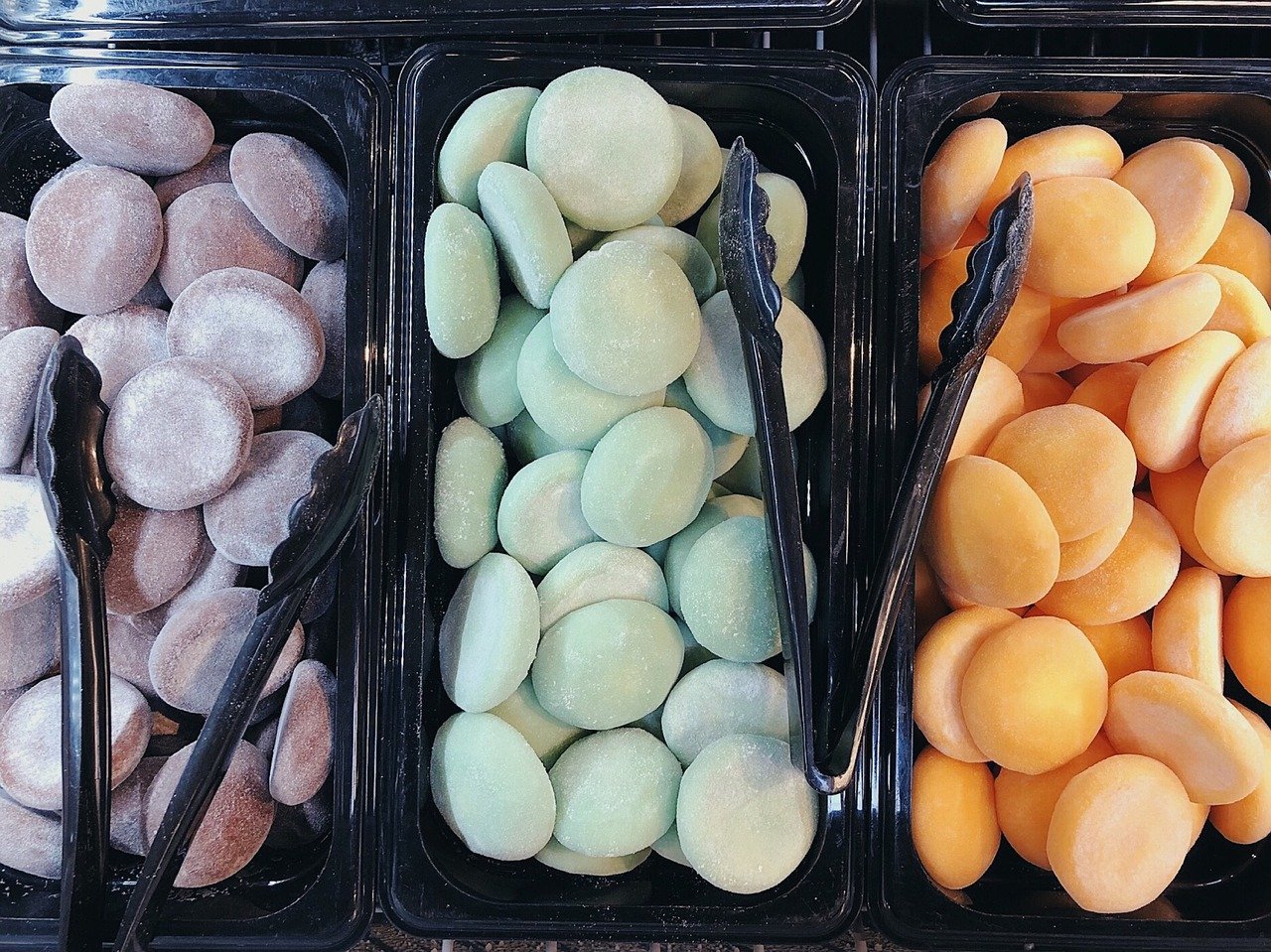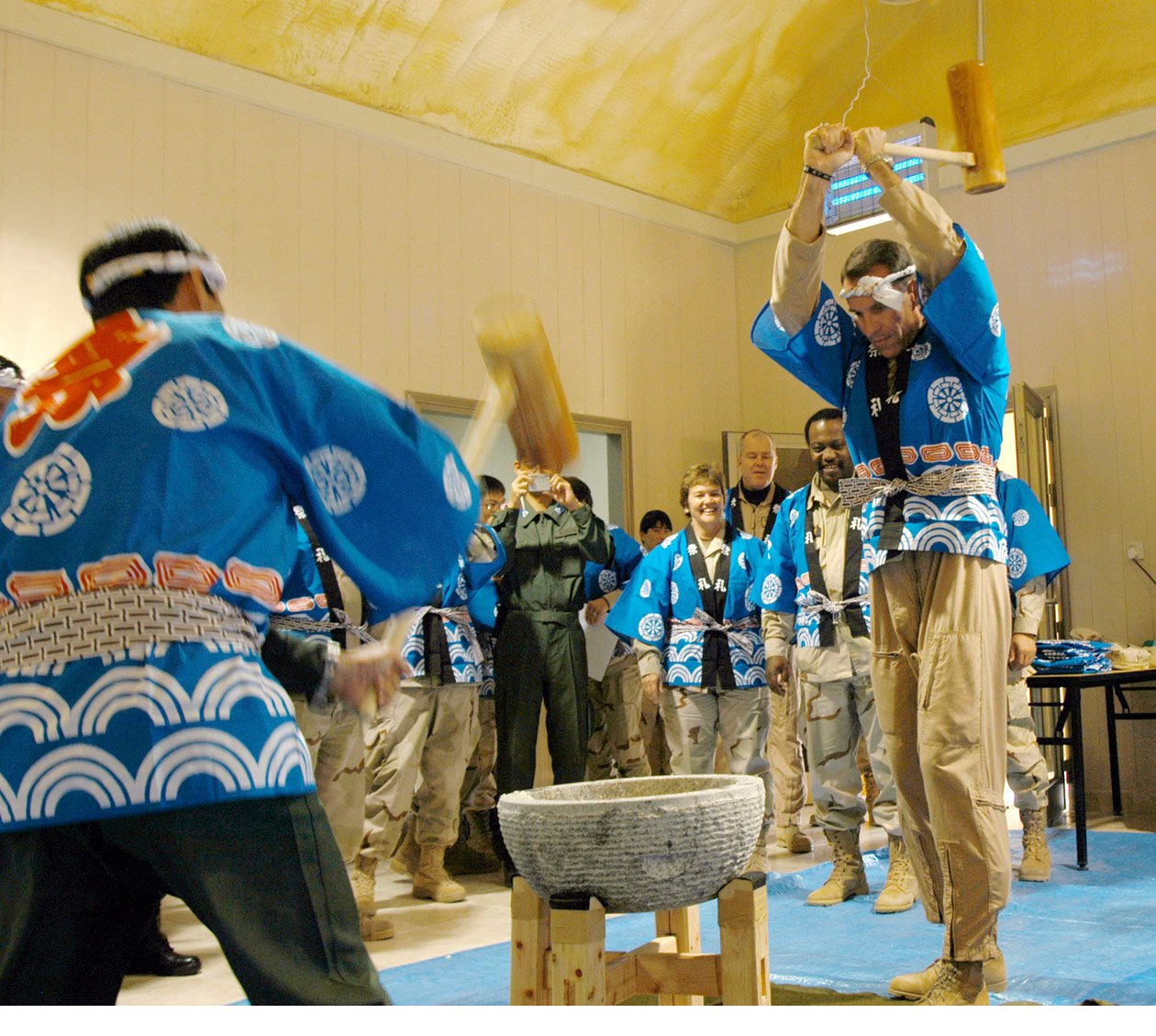What is Mochi?
A deliciously sticky rice cake, Mochi has been a part of the culture and tradition of Japan since the year 794 during the Japanese Heian period, and has been used for several ceremonies and modern functions. The most common one, and perhaps the one most strongly linked with its identity, is the use of Mochi in the New Year ceremonies of Japan. It is a part of the Kagami Mochi, a decoration that is broken and eaten symbolic of opening a mirror, Zōni, a traditional soup made with taro, carrots, and honeyworts, and Kinako Mochi, created as an emblem of good luck.

The glutinous rice cakes find their origins linked with the Shinto religion where they were offered to the Gods, asking for good fortune and happy marriages. They have since been used for several different reasons – by the Japanese Samurai for their small size and filling nature, by the nobles and imperial court during New Year festivities during the Heian period. More recently, Mochi is used as a dessert made in a variety of flavors such as green tea, served with ice cream, or as a savory meal served wrapped in dried seaweed and served with soy sauce. You can find accounts of the traditional Mochi in the oldest Japanese novel, The Tale of Genji.
Made of short-grain japonica rice, the rice cakes are now a regular part of the diet in Japan. They are traditionally made in a pounding ritual known as Mochitsuki, where they are soaked overnight, steamed, mashed and pounded with wooden mallets, and then formed into spheres or cubes. Using modern equipment, you can also make them at home where technology automates the laborious pounding. The production involves four main processes i.e., selection of the specific types of rice, attaining consistency of the dough through the pounding process, shaping into a favorable size, and filling the Mochi with flavors.
Also read: Top Japanese Food & Dishes
Is Mochi Healthy?
Mochi is a versatile, healthy snack commonly consumed as a part of the Japanese diet. From its very origins, it has been especially popular with rice farmers to increase their stamina and with Samurai for its ease of convenience. The most significant benefit of Mochi is the fact that it is convenient to carry, is incredibly filling, and you only need a small matchbox-sized portion to replace an entire bowl of rice.

Other than this, Mochi is also extremely healthy as it is one of the few carbohydrate sources that is packed with protein and is gluten and cholesterol-free. This is mainly due to two reasons, the first one being the ingredients used while making it i.e., the japonica glutinous rice, water, sugar, cornstarch. The short-grain japonica glutinous rice is its primary ingredient and lends it most of its nutritional value. It has a higher protein content as compared to other short-grain rice. The second reason being the method of preparation wherein the rice is steamed, pounded into flour, and then shaped. As a result of this process, the Mochi doesn’t have gluten and is cholesterol-free.
One serving or 44 grams of Mochi has a total of 96 calories, zero trans-fat, 22 grams carbohydrates, and 1 gram protein. When combined with seaweed, Mochi is also rich in Vitamins A, C, E, K, and is a good source of Phosphorus, Calcium, Iron, Magnesium, Copper, and Manganese.
Is Mochi Dangerous to Eat?
Mochi is delicious and healthy, but it can also be deadly if you do not take proper precautions while eating it. It is dangerous because of its glutinous makeup and dense, thick, sticky texture that can cause choking.
To eat these dense, sticky buns, you should cut them into small, bite-sized pieces, not larger than the size of a small matchbox, and then chew each piece thoroughly and swallow slowly. This produces enough saliva to moisten the buns and avoid choking. Most Mochi eaters follow a strict eating procedure that involves a lot of chewing and careful swallowing. Mochi can be especially dangerous for those who have difficulty following this procedure either in the inability to chew or in trouble swallowing. Young children and senior citizens are especially vulnerable to this and should avoid consuming Mochi altogether.
Accidents and even deaths due to Mochi tend to be so severe that Japanese officials issue warnings every year on the correct method of eating Mochi and what to do in case of choking. Choking mainly happens when people overeat too quickly, and without following the Mochi eating procedure carefully. If choking does occur, Japanese officials advise that the victim should bend over so that the person assisting can hit hard on their back and hold their lower jaw to help them remove the Mochi.
When is Mochi eaten? And What do they taste like?
The Japanese Mochi is more about the texture than the taste. You can picture it being a cross being a marshmallow and a gummy bear with a starchy aftertaste. But it is hardly ever consumed by itself. It is generally either filled with fun flavors or wrapped in complementary leaves. A popular way to consume these traditional rice cakes is with ice cream, where a scoop of ice cream is wrapped within a very thin layer of Mochi. You can also relish a savory variant of Mochi, that is covered within dried seaweed and served with soy dipping sauce.

Mochi is commonly available across Japan in supermarkets, bakeries, and pantries, but is most widely consumed as part of the various celebrations such as New Years, Children’s Day, Sakura or Cherry Blossoms, and Girls Day.
On the arrival of Spring and the Sakura Cherry Blossom season, you can enjoy Mochi as Sakuramochi, a pink Mochi wrapped in a salted cherry leaf which is symbolic of the Sakura. On 5th May or Children’s Day, Mochi is made into two variants namely Kashiwamochi, a white mochi with sweet and delicious Anko filling wrapped in a Kashiwa oak leaf, and chimaki, a variant of Dango covered in bamboo leaves. On Girls Day or 3rd March, you can enjoy a rhomboid-shaped Mochi, or Hishi Mochi, which has layers of red, green, and white, that get their colors from jasmine, water caltrop, mugwort respectively.
